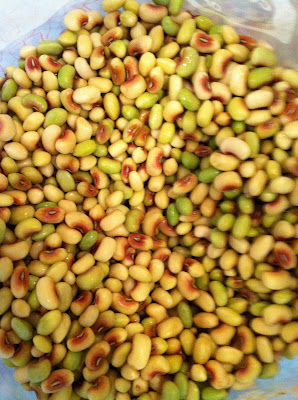 |
| HOPPIN JOHN |
For those of you "not from here", Hoppin' John is basically peas and rice. It is a southern United States version of the traditional rice and beans dish from West Africa. In the southern coastal areas, we use field peas; black eyed peas are used most everywhere else. For the most part, in everything I've read, Hoppin' John seems to come from the Low Country cuisine of the Carolinas, which is the cooking style most associated with the sea islands - the cluster of coastal islands off S. Carolina and Georgia (surely, you've heard of Sea Island, Georgia, a beautifully peaceful place). It is usually prepared by simmering the peas with a ham hock and some veggies - I tend to take the (Louisiana) Trinity approach on the veggies: onions, celery and bell pepper.
You've possibly heard of Hoppin' John referenced as served with collards or other greens for a traditional southern New Years Day dish. It is said to bring good luck. There are tons of legends about how the dish got its name ... everything from a crippled man, nick-named Hoppin' John, selling the dish in Charleston, to the custom of southern children hopping once around the table before the dish was served. But the one I like best (because it definitely defines what I have seen of some parts of South Carolina) is that a SC custom was to invite a guest over to eat by saying "Hop In John!" One thing I do know for sure is that it is a "tradition": It was first written in a cookbook called The Carolina Housewife, by Sara Rutledge, published in 1847.
Most recipes are rather similar, but there are definitely different variations. Some cook the peas with the rice, some ladle them (and their "pea liquor") over the rice. I like to cook my peas separately from my rice. Here's my version:
INGREDIENTS:
For the peas:
1 Vidalia Onion, medium diced
1/2 cup celery, small dice
1/4 cup red bell pepper, small dice
1 tsp garlic, minced
1 tsp jalapeno pepper, minced
1 Tbsp Olive Oil (Extra Virgin is my favorite)
2 cups Chicken Stock
2 cups water
1 quart Field Peas (should be a little over a pound when thawed)
1 tsp dried thyme
1 tsp cayenne pepper
Fresh Ground Pepper and Kosher Sea Salt
3 slices thick cut Applewood Smoked Bacon
For the rice:
1 cup of Uncle Ben's (no lie - Uncle Ben's is the only way to go)
2 cups water
1 Tbsp Salted Butter
Salt
DIRECTIONS:
DICE Your Veggies ... Small on the celery, Medium on the onion and Small on the bell pepper
(1) Heat a medium dutch oven with olive oil in it and saute the onions, celery and bell pepper (I use red because it's pretty ... green can also be used - that's more traditional for the Trinity. Personal Preference here!) for about 4 minutes - keep the crunch ... don't let the onions get too soft.

(2) Add the garlic and jalapeno and saute till just "fragrant" - lots of people ask what that means. I usually don't saute garlic and jalapenos for longer than a minute otherwise the garlic burns and the dish is better off in the trashcan. burnt garlic = yuck. It can overcome the taste of any dish.

 (3) Add the peas, the stock (I use 2 cups+ stock and cut it with 2 cups- water because my stock is homemade, and tends to be a little more heavy than most) the water, all the seasonings and bacon. Bring to a boil, and turn it down to simmer till the peas are YOUR DESIRED CONSISTENCY. I stress this because some people would cook them all day till they are really creamy; others might like them cooked for only about 20mins - just till tender.
(3) Add the peas, the stock (I use 2 cups+ stock and cut it with 2 cups- water because my stock is homemade, and tends to be a little more heavy than most) the water, all the seasonings and bacon. Bring to a boil, and turn it down to simmer till the peas are YOUR DESIRED CONSISTENCY. I stress this because some people would cook them all day till they are really creamy; others might like them cooked for only about 20mins - just till tender. For the Rice:
Put it all in a small pot, cover with a lid, bring to a boil and turn it down to low and let it go for 20mins. Right before you serve, fluff it with a fork and put the lid back on.
WINE PAIRING: Those of you who know me, know that I usually don't match my food to my wines - red meat + red wine / pork + white wine - but the recipe I used for the pork chops (coming up next) uses 1/2 cup of white wine, and it was open ... and it sure was a good match! So, try the 2010 Vincent Delaporte Sancerre, from the Loire Valley. Should run you about $25 (a steal!). I keep about 1/2 a case of this in my wine fridge all the time. It's good, balanced, light, crisp. Great summer drinking!


















































